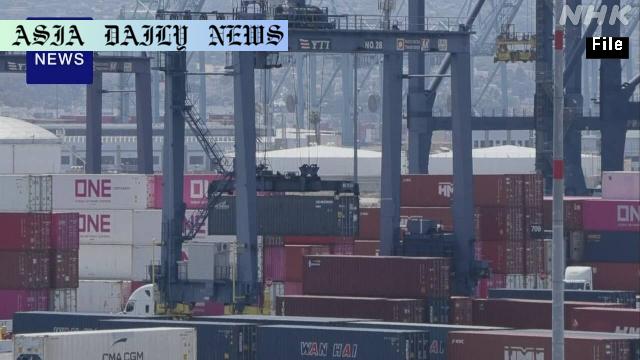Tariffs result in unexpected rise in import volume at Los Angeles port, showcasing a ‘whipsaw effect’.
- Tariffs impacted imports at the Port of Los Angeles, showing a 32% rise in June.
- The US-China agreement on tariff reductions is the key driver of this spike.
- Unscheduled container vessels also contributed to the increase.
- The tariff ‘whipsaw effect’ was cited by port officials as a major factor.

The Impact of Tariffs on Global Trade Dynamics
Tariffs have long served as a crucial tool in shaping global trade dynamics, affecting everything from price stability to import-export relationships between nations. The recent surge in inbound cargo at the Port of Los Angeles—a staggering 32% increase in June—provides a compelling case study of how tariff policies reverberate through economic systems. The backdrop here is the temporary easing of the escalating US-China tariff conflict, which allowed for significantly increased shipments from China to the United States. This uptick underscores the inherent unpredictability and ripple effects of trade policies between economic powerhouses.
Port authorities attribute this spike to what they aptly describe as a ‘tariff whipsaw effect.’ The whipsaw phenomenon highlights the erratic surges and drops in trade that occur in response to rapid policy changes, such as tariff hikes or reductions. Uncertainty, compounded by preemptive decision-making by exporters and importers, leads to abrupt shifts in shipment levels. This particular scenario also saw the arrival of unscheduled container vessels post-mid-June, further proving businesses’ tendency to capitalize on fleeting opportunities within the fluctuating trade environment.
The Role of US-China Trade Talks
The mid-May agreement between the United States and China to pare down reciprocal tariffs breathed new life into a trade relationship strained by years of conflict. It is vital to recognize that this temporary truce not only facilitated smoother trade flows during June but also reflected the interdependence of the two economies. Nearly every trade analyst agrees that Asia—particularly China—serves as a linchpin for US imports. The spike at the LA Port, a critical gateway to Asia, reinforces this notion. However, the political and economic implications of these hefty tariff policies are far from straightforward, as evidenced by US President Donald Trump’s decision to extend the tariff deadline to August 1.
This calculated extension suggests a strategic attempt to exert leverage during trade negotiations, emphasizing short-term economic gains while potentially delaying long-term trade equilibrium. The impending August deadline portends yet another phase of the ‘whipsaw effect,’ with stakeholders on all sides anticipating a further surge in shipments ahead of the cutoff.
Consequences for Global Supply Chains
The sharp increase in inbound shipments at the Port of Los Angeles raises important questions about the resilience of global supply chains. Such sudden spikes invariably test the logistics capacities of ports, shipping companies, and dependent industries. Shippers scrambling to move goods amid tariff reductions risk overburdening existing infrastructures, leading to delays, increased costs, and systemic inefficiencies. Meanwhile, businesses reliant on imports struggle to navigate fluctuating costs and delivery timelines, exacerbating uncertainty.
These issues aren’t isolated to the US-China trade battle but are emblematic of global economic trends that prioritize short-term gains over robust, long-term solutions. Policymakers across the globe must grapple with a critical question: how can global trade policies be designed to minimize volatility and foster stability without sacrificing economic advantage? The Port of Los Angeles’ recent experience underscores the urgency of tackling these challenges before they spiral out of control.
Looking Towards the Future
With the August tariff deadline looming, one can expect a final, frenzied push in imports. While such events may temporarily buoy economic indicators, they also signal the precariousness inherent in relying on trade policy alone to drive economic health. The LA Port’s June surge encapsulates not just a momentary economic boost but also a cautionary tale about the need for strategic foresight in trade negotiations. Rational, well-informed policy decisions that integrate long-term supply chain considerations will be pivotal in shaping the next chapter of global trade dynamics.



Commentary
A Closer Look at the Tariff ‘Whipsaw Effect’
The term ‘whipsaw effect’ aptly captures the volatility and unpredictability caused by rapid policy changes, and the situation at the Port of Los Angeles serves as a textbook example. The 32% jump in cargo imports in June is remarkable, but it also prompts important questions about the sustainability of such spikes. While businesses understandably scrambled to capitalize on the respite offered by the mid-May US-China trade agreement, one must wonder whether this momentary boost masked deeper issues within global trade systems.
The unpredictability inherent in such trade negotiations places undue strain on global supply chains. The increased influx of containers stretches port capacity and creates logistical difficulties, which in turn can lead to delayed shipments or higher operational costs. Policymakers and businesses alike must recognize that this model of erratic spikes and drops is unsustainable in the long run. It’s time for a more stable and coordinated approach to trade policies, one that prioritizes long-term growth over reactionary measures.
The Bigger Picture of US-China Relations
The case of the Port of Los Angeles also highlights the interconnected nature of US-China economic relations. As key players in the global economy, the policies enacted by these two nations have ramifications far beyond their borders. The June surge at the LA Port is not just a reflection of a temporary tariff reprieve but also a testament to the reliance both economies have on one another. Every unscheduled container vessel docking at the port underscores the global stakes inherent in their negotiations.
However, it is also important to consider the human and logistical dimensions of these changes. From customs officers to truck drivers, a wide array of individuals and industries are directly impacted by shifts in trade volume. The whipsaw effect may capture headlines with its dramatic numbers, but its real cost is often borne by those working behind the scenes to keep the global trade machine running smoothly.